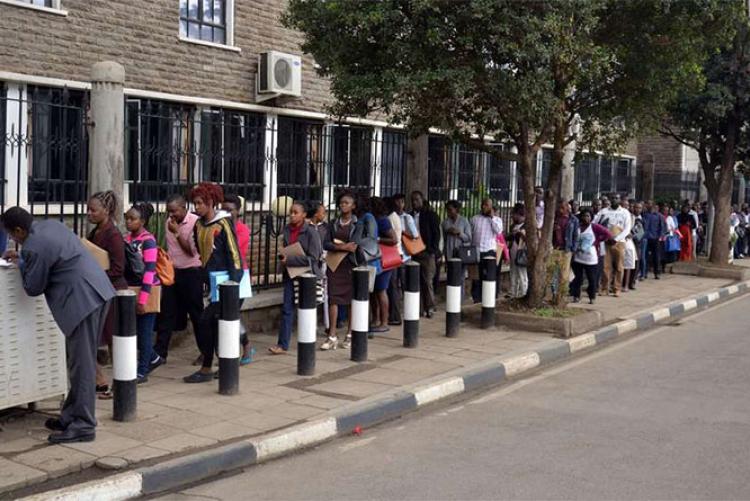Some 771, 439 youths lost their jobs in the three months to March and before the imposition of coronavirus disease restrictions that have led to further layoffs and pay cuts.
Data from the Kenya National Bureau of Statistics (KNBS) shows that number of Kenyans between the ages of 20 and 34, who are in employment or running a business, dropped 9.89 percent to 7.02 million.
Young people are the hardest hit by joblessness compared to their counterparts aged above 35 years in an economic setting that is plagued by a hiring freeze on the back of sluggish corporate earnings.
This is a major blow to jobseekers, especially the close to one million young people who graduate from various educational institutions every year.
The Quarterly Labour Force Report reflected a grim period for workers and businesses before Kenya reported its first case of Covid-19 on March 12, which ushered in restrictions on travel, mass gathering and a dusk-to-dawn curfew.
The restrictions were imposed on March 25, meaning that KNBS jobs data covers the latter days of the month and points to a worsening of the employment market in the second quarter when business reeled most from effects of the coronavirus.
However, the decline in employment opportunities for the youth was counterbalanced by the growth of jobs for those aged above 35 years, which rose to 962,471 to 9.55 million in quarter one.
KNBS director-general Zachary Mwangi reckons that the rise in opportunities for those above 35 years is tied to the fact that a majority of them run businesses, which is captured as employment.
“They (older population) normally have an economic activity they are undertaking. Most of them, for instance, have own businesses,” Mr Mwangi told the Business Daily in an interview, adding that unemployment reduces with age. This is the second employment report that will be released quarterly, a departure from the past when KNBS only published annual job reports.
The survey indicates that a total of 3,870,478 — or 35.52 percent of the nearly 10.90 million young Kenyans — were jobless as at end of March 2020, slightly worse than 34.28 percent or 3,359,505 million three months earlier.
However, the State defines the unemployed as people who do not have a job and have actively been looking for employment in recent weeks.
Under this definition, the government puts the number of unemployed Kenyans at 914,704, or 4.9 percent in the three months to March with the youth accounting for 596,614. “The unemployment rate, measured based on the strict definition, was 4.9 percent for first quarter 2020, same as that of the previous quarter. This was 1.3 percentage points lower compared to that of the same quarter last year,” the KNBS analysts wrote in the report.
“The youth aged 20-24 had the highest proportion of the unemployed at 12.5 percent. On the other hand, those aged 55-59 had the least unemployment rate of 0.3 percent.”
About 478,513 Kenyans between the ages of 15 and 19 years lost their jobs between January and March this year.
The number of formal jobs generated by the economy fell to a seven-year low in 2019.
The economy generated only 78,400 new formal jobs last year, but informal jobs, which rose from 744,000 in 2018 to 767,900 last year.
Figures for this year will likely be hit by the effects of the Coronavirus disease.
Companies started reporting falling sales ahead of Kenya imposing restrictions to curb the spread of coronavirus.
Kenya, which has reported 2,021 positive cases of Covid-19 and 69 deaths, has suspended commercial flights in and out of the country, banned public gatherings and imposed a dusk-to-dawn curfew since March.
It has also halted movement in and out of five counties most affected by the virus, including Nairobi and Mombasa.
This has seen businesses cut down their activities in response to the fall in consumer demand, triggering layoffs, unpaid leave and salary cuts.
The Markit Stanbic Bank Kenya Purchasing Managers’ Index (PMI)--which tracks business performance monthly-- tumbled to 34.8 in April from 37.5 in March. Readings below 50.0 indicate a contraction.
“It’s safe to say that, at least with anecdotal evidence available so far, the epicentre of the COVID-19 impact on economic activity will be in the second quarter of this year,” said Jibran Qureishi, economist for East Africa at Stanbic Bank.
“Firms shed jobs at the fastest pace in the survey history, with wages also reduced amid efforts to lower total costs.”
The World Bank expects Kenya’s economic growth to drop to 1.5 percent this year, and contract one percent in the worst-case scenario under the impact of the coronavirus outbreak, down from a 5.4 percent growth last year.

